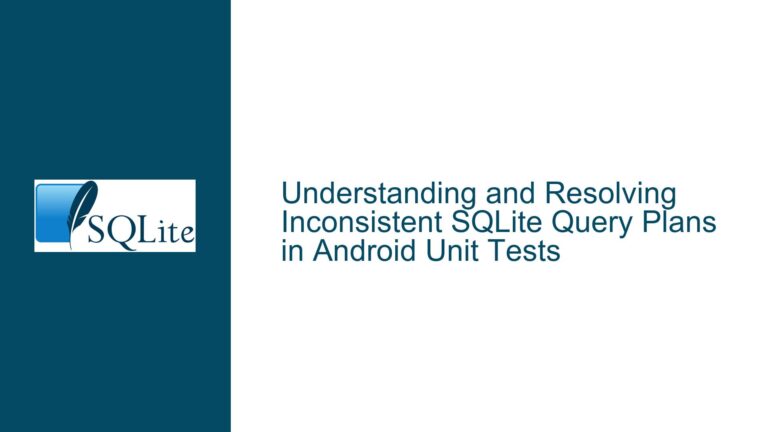sqlite3_release_memory vs sqlite3_db_release_memory and Memory Management in SQLite
Issue Overview: Memory Management in SQLite and the Role of sqlite3_release_memory and sqlite3_db_release_memory
Memory management is a critical aspect of working with SQLite, especially in environments with constrained resources such as embedded systems. SQLite provides several mechanisms to manage memory usage, including the functions sqlite3_release_memory and sqlite3_db_release_memory. These functions are designed to help developers free up memory that SQLite has allocated, but they serve different purposes and have different constraints.
The function sqlite3_release_memory is a global memory release function that attempts to free as much memory as possible from all database connections associated with the SQLite instance. However, this function is only available if SQLite is compiled with the SQLITE_ENABLE_MEMORY_MANAGEMENT option, which is not enabled by default. This means that unless you have compiled SQLite yourself with this specific option, sqlite3_release_memory will not be available for use.
On the other hand, sqlite3_db_release_memory is a more targeted function that releases memory associated with a specific database connection. This function is available in the standard build of SQLite and does not require any special compilation flags. It is particularly useful when you want to free up memory for a specific database connection without affecting other connections.
The core issue here is understanding when and how to use these functions effectively, especially in environments where memory is a scarce resource. Additionally, the discussion touches on the use of sqlite3_int64 intSoftHeap, which is related to SQLite’s soft heap limit mechanism. This mechanism allows developers to set a limit on the amount of memory that SQLite can allocate, which can be useful in preventing memory exhaustion in constrained environments.
However, it is important to note that relying solely on these memory management functions is not a substitute for good schema design and query optimization. Poor schema design, lack of normalization, missing indices, and inefficient queries can lead to excessive memory usage, which these functions cannot fully mitigate. Therefore, while understanding these functions is important, they should be used in conjunction with best practices in database design and query optimization.
Possible Causes: Why Memory Management Functions May Not Solve Underlying Issues
The primary cause of memory issues in SQLite often lies in the schema design and query execution rather than the lack of memory management functions. When a database schema is not properly normalized, it can lead to redundant data storage, which in turn increases memory usage. For example, storing the same piece of information in multiple tables without proper relationships can cause SQLite to allocate more memory than necessary.
Another common cause of memory issues is the absence of appropriate indices. Indices are crucial for speeding up query execution, but they also play a role in memory management. When a query is executed without an index, SQLite may need to perform a full table scan, which can be memory-intensive. This is especially true for large tables where the lack of an index forces SQLite to load large amounts of data into memory.
Inefficient query plans can also contribute to memory problems. SQLite generates a query plan for each SQL statement, and if the plan is not optimal, it can lead to excessive memory usage. For example, a query that involves multiple joins or subqueries may result in a complex query plan that requires more memory to execute. In some cases, the query planner may choose a plan that is not the most memory-efficient, even if it is faster in terms of execution time.
The use of sqlite3_int64 intSoftHeap can help mitigate some of these issues by setting a soft limit on the amount of memory SQLite can allocate. However, this is not a foolproof solution. If the soft heap limit is set too low, SQLite may not be able to execute queries efficiently, leading to performance degradation. On the other hand, if the limit is set too high, it may not effectively prevent memory exhaustion.
In summary, while sqlite3_release_memory and sqlite3_db_release_memory can help free up memory, they are not a cure-all for memory issues. The root cause of memory problems in SQLite often lies in the schema design, lack of indices, and inefficient query plans. Addressing these underlying issues is crucial for effective memory management.
Troubleshooting Steps, Solutions & Fixes: Addressing Memory Issues in SQLite
To effectively address memory issues in SQLite, it is important to take a holistic approach that includes both the use of memory management functions and improvements to schema design and query optimization. Here are some detailed steps and solutions to help troubleshoot and resolve memory issues in SQLite:
1. Schema Design and Normalization:
The first step in addressing memory issues is to ensure that the database schema is properly normalized. Normalization involves organizing the data in the database to reduce redundancy and improve data integrity. For example, instead of storing the same piece of information in multiple tables, you can use foreign keys to establish relationships between tables. This not only reduces memory usage but also makes the database easier to maintain.
Additionally, consider the use of appropriate data types for each column. Using the correct data type can help reduce memory usage by ensuring that only the necessary amount of memory is allocated for each value. For example, using an INTEGER data type for a column that stores small numbers is more memory-efficient than using a TEXT data type.
2. Indexing:
Proper indexing is crucial for both performance and memory management. Indices allow SQLite to quickly locate the data needed for a query, reducing the need for full table scans. However, it is important to strike a balance between the number of indices and memory usage. Creating too many indices can lead to increased memory usage, as each index requires additional memory to store.
When creating indices, consider the types of queries that will be executed against the database. For example, if a query frequently filters data based on a specific column, creating an index on that column can significantly improve performance and reduce memory usage. Additionally, consider using composite indices for queries that filter data based on multiple columns.
3. Query Optimization:
Optimizing queries is another important step in reducing memory usage. Start by analyzing the query plans generated by SQLite for each query. The query plan provides insight into how SQLite will execute the query, including the order in which tables are accessed and the methods used to retrieve data.
Look for opportunities to simplify queries by reducing the number of joins or subqueries. In some cases, breaking down a complex query into smaller, more manageable queries can help reduce memory usage. Additionally, consider using EXPLAIN QUERY PLAN to identify potential bottlenecks in the query execution process.
Another technique for optimizing queries is to use prepared statements. Prepared statements allow SQLite to compile a query once and reuse the compiled statement for subsequent executions. This can reduce memory usage by avoiding the need to recompile the query each time it is executed.
4. Memory Management Functions:
While memory management functions should not be relied upon as the sole solution for memory issues, they can be useful in certain situations. If you have compiled SQLite with the SQLITE_ENABLE_MEMORY_MANAGEMENT option, you can use sqlite3_release_memory to free up memory from all database connections. This function is particularly useful in environments where memory is extremely constrained.
For more targeted memory management, use sqlite3_db_release_memory to free up memory associated with a specific database connection. This function is available in the standard build of SQLite and can be used to release memory when a specific connection is no longer needed.
5. Soft Heap Limit:
The sqlite3_int64 intSoftHeap mechanism allows you to set a soft limit on the amount of memory SQLite can allocate. This can be useful in preventing memory exhaustion in constrained environments. However, it is important to set the soft heap limit carefully. Setting the limit too low can lead to performance degradation, while setting it too high may not effectively prevent memory exhaustion.
To set the soft heap limit, use the sqlite3_soft_heap_limit64 function. This function allows you to specify the maximum amount of memory SQLite can allocate before it starts to release memory. Monitor the performance of your application after setting the soft heap limit to ensure that it does not negatively impact query execution.
6. Monitoring and Profiling:
Finally, it is important to continuously monitor and profile your SQLite database to identify potential memory issues. Use tools such as sqlite3_status to monitor memory usage and identify areas where memory is being allocated excessively. Additionally, consider using profiling tools to analyze the performance of your queries and identify potential bottlenecks.
Regularly review the schema design, indices, and queries to ensure that they are optimized for both performance and memory usage. By taking a proactive approach to memory management, you can prevent memory issues from arising in the first place.
In conclusion, addressing memory issues in SQLite requires a combination of good schema design, proper indexing, query optimization, and the judicious use of memory management functions. By following these steps, you can effectively manage memory usage in SQLite and ensure that your database performs efficiently, even in constrained environments.






